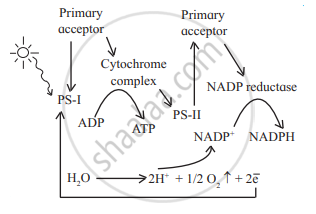Advertisements
Advertisements
Question
Answer the following question.
Describe the light-dependent steps of photosynthesis. How are they linked to the dark reactions?
Answer in Brief
Solution
The light-dependent steps of photosynthesis include cyclic and non-cyclic photophosphorylation.
- Cyclic photophosphorylation:
- Illumination of photosystem-I causes electrons to move continuously out of the reaction center of photosystem-I and back to it.
- The cyclic electron-flow is accompanied by the photophosphorylation of ADP to yield ATP. This is termed as Cyclic photophosphorylation.
- Since this process involves only pigment system I, photolysis of water and consequent evolution of oxygen does not take place.

- Non-cyclic photophosphorylation:
- It involves both photosystems- PS-I and PS-II.
- In this case, electron transport chain starts with the release of electrons from PS-II.
- In this chain high energy electrons released from PS-II do not return to PS-II but, after passing through an electron transport chain, reach PS-I, which in turn donates it to reduce NADP+ to NADPH.
- The reduced NADP+ (NADPH) is utilized for the reduction of CO2 in the dark reaction.
- Electron-deficient PS-II brings about oxidation of water-molecule. Due to this, protons, electrons and oxygen atom are released.
- Electrons are taken up by PS-II itself to return to reduced state, protons are accepted by NADP+ whereas oxygen is released.
- As in this process, high energy electrons released from PS-II do not return to PS-II and it is accompanied with ATP formation, this is called Non-cyclic photophosphorylation.

where CO-Q: Co-enzyme quinone
FRS: Ferredoxin Reducing Substance
PC: Plastocyanin
PQ: Plastoquinone
Cyt: Cytochrome
Fd: Ferredoxin.
- Link between light-dependent and dark reactions:
Link between light-dependent and dark reactions: The light reaction gives rise to two important products, a reducing agent NADPH2 and an energy-rich compound ATP. Both these are utilized in the dark phase of photosynthesis.
ATP and NADPH2 molecules function as vehicles for the transfer of energy of sunlight into dark reaction leaving to carbon fixation. In this reaction, CO2 is reduced to carbohydrates.
During dark reaction, ATP and NADPH2 are transformed into ADP, iP and NADP which are transferred to the grana in which light reaction takes place.
shaalaa.com
Role of Sunlight in Photosynthesis - Photophosphorylation
Is there an error in this question or solution?
Chapter 12: Photosynthesis - Exercise [Page 150]
APPEARS IN
RELATED QUESTIONS
Choose the correct option.
Non-cyclic photophorylation differs from cyclic photophosphorylation in that former.
Is there something wrong with following the schematic presentation? If yes, correct it so that photosynthesis will be operated.

The process of conversion of ADP to ATP during photosynthesis is called ______.
